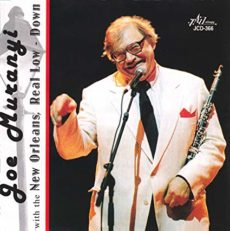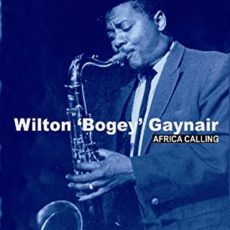
Daily Dose Of Jazz…
Joseph P. Muranyi was born in Martins Ferry, Ohio on January 14, 1928 and studied with Lennie Tristano, however, he was primarily interested in early jazz styles such as Dixieland and swing. After playing in a United States Army Air Forces band, he moved to New York City in the 1950s and attended the Manhattan School of Music and Columbia University.
During the 1950s he played under Eddie Condon, collaborating with Jimmy McPartland, Max Kaminsky, Yank Lawson, Bobby Hackett, and Red Allen. During that decade he also played with the Red Onion Jazz Band, Danny Barker, and Wingy Manone.
1963 saw him playing with The Village Stompers, a Dixieland band that reached the pop charts with its song Washington Square. From 1967 to 1971 he was the clarinetist with the Louis Armstrong All-Stars. After initially struggling to pronounce Muranyi’s Hungarian family name, Armstrong introduced him on stage as “Joe Ma Rainey”, to Muranyi’s own amusement. Following this stint, he played with Roy Eldridge, World’s Greatest Jazz Band, Cozy Cole, Lionel Hampton, Herman Autrey, Wild Bill Davison, Zutty Singleton, and others.
He worked extensively as a record producer and wrote liner notes for hundreds of albums. Clarinetist, producer, writer and critic Joe Muranyi, who was also an enthusiastic vocalist and played both soprano and tenor saxophone, passed away in Manhattan, New York on April 20, 2012.

Daily Dose Of Jazz…
Putney Dandridge was born Louis Dandridge on January 13, 1902 in Richmond, Virginia, and began performing in 1918 as a pianist in a revue titled The Drake and Walker Show. 1930 saw him working as an accompanist for tap dancer Bill “Bojangles” Robinson, including appearances in the musical Brown Buddies. In 1931, he appeared in the cast of the musical revue Heatin’ Up Harlem, starring Adelaide Hall at the Lafayette Theatre in Harlem. In the 1932 American film, Harlem Is Heaven, Dandridge, on the piano and reciting lyrics in a speak set, accompanies Robinson as the dancer sings “Is You Is Or Is You Ain’t“.
After touring in Illinois and the Great Lakes region, Putney settled in Cleveland, Ohio, forming a band with guitarist Lonnie Johnson. This period lasted until 1934 when he attempted to perform as a solo act. He took his show to New York City, beginning a series of long residences at the Hickory House on 52nd Street and other local clubs. From 1935 to 1936, he recorded numerous sides under his own name, many of which highlighted some major jazz talents of the period, including Roy Eldridge, Teddy Wilson, Henry “Red” Allen, Buster Bailey, John Kirby, Chu Berry, Cozy Cole and more.
Appearing to vanish from the music scene in the late thirties, it has been speculated that he may have been forced to retire due to ill health. Pianist Putney Dandridge passed away on February 15, 1946 in Wall Township, New Jersey at the age of 44.
More Posts: piano

Requisites
The Yuko Mabuchi Trio, Volume 1 is a 2017 live recording by the trio at The Brain and Creativity Institute’s Cammilleri Hall in Los Angeles, California on March 31, 2017. It was recorded in honor of the 25th Anniversary of The Los Angeles and Orange County Audio Society, and their President, Bob Levi who was celebrating his 70th Birthday and released on the Yarlung Records label. The executive producer was Randy Bellous.
Track List |- What Is This Thing Called Love?
- Valse Noire
- On Green Dolphin Street
- Seriously
- Yuko Mabuchi ~ piano
- Del Atkins ~ bass
- Bobby Breton ~ drums
Review by Eddie Carter
On the stage, a beautiful young woman sits at a baby grand piano unleashing an aggressive flood of sound into the audience. Behind her are two elegantly dressed gentlemen, Del Atkins on bass and Bobby Breton on drums, who match her creativity, precise timing, and articulation with their own musical artistry note-for-note. Her name is Yuko Mabuchi.
The four-song album opens with one of Cole Porter’s most recorded compositions, the 1929 classic, What Is This Thing Called Love?, composed for the Broadway musical, Wake Up and Dream. It is followed by the very pretty ballad Valse Noire by Cincinnati, Ohio composer Mark Lehman who originally wrote the tune for solo piano. The pace slows down as the second side begins with the 1947 popular song On Green Dolphin Street by Bronislaw Kaper and Ned Washington. It was composed for the film Green Dolphin Street released that year and became a jazz standard after Miles Davis recorded it on his 1958 Columbia album, Jazz Track. The album closes with Seriously by singer-songwriter Sara Bareilles who wrote it for fellow singer Leslie Odom, Jr., who appeared on the weekly public radio program and podcast, This American Life.
Source: Jazztracks by Eddie Carter | Excerpt: 12/2018 | atlantaaudioclub.org
More Posts: choice,classic,collectible,collector,history,instrumental,jazz,music,piano

Daily Dose Of Jazz…
Olu Dara was born Charles Jones III on January 12, 1941 in Natchez, Mississippi. After moving to New York City In 1963, he changed his name to Olu Dara, which means “God Is Good” in the Yoruba language. In the Seventies and Eighties, he played alongside David Murray, Henry Threadgill, Hamiet Bluiett, Don Pullen, Charles Brackeen, James Blood Ulmer, and Cassandra Wilson. He formed two bands, the Okra Orchestra and the Natchezsippi Dance Band.
His first album, In the World: From Natchez to New York, released in 1998, revealed another aspect of his musical personality: the leader and singer of a band immersed in African-American tradition, playing an eclectic mix of blues, jazz, and storytelling, with tinges of funk, African popular music, and reggae. His second album Neighborhoods, with guest appearances by Dr. John and Cassandra Wilson, followed in a similar vein.
Dara played on the 1994 album Illmatic, on the song Dance, and he sang on the 2004 song Bridging the Gap, all by his son, rapper Nas. Besides recording two albums as a leader, cornetist, guitarist and singer Olu Dara has recorded fifty-four as a sideman with the likes of Doug Carn, Oliver Lake, Julius Hemphill, Nona Hendryx, The Be Good Tanyas, Rickie Lee Jones, Terumasa Hino, Jack McDuff, Dirty Dozen Brass Band, and James Newton, among others.
More Posts: bandleader,cornet,guitar,history,instrumental,jazz,music,vocal

Daily Dose Of Jazz…
Wilton “Bogey” Gaynair was born on January 11, 1927 in Kingston, Jamaica, Gaynair was raised at Kingston’s Alpha Boys School, where fellow Jamaican musicians Joe Harriott, Harold McNair and Don Drummond were also pupils of a similar age.
Beginning his professional career playing in Kingston’s clubs backing such performers as George Shearing and Carmen McRae, he traveled to Europe in 1955, basing himself in Germany because of the plentiful live work that was offered. Bogey recorded only three times as a bandleader and two of those recordings came during visits to England, 1959’s Blue Bogey and Africa Calling in 1960, on Tempo Records but the latter went unreleased until 2005 due to the label’s demise.
Gaynair returned to Germany shortly after recording these sessions where he remained based for the rest of his life. He concentrated on live performance with such bands as the Kurt Edelhagen Radio Orchestra and played at the opening ceremony of the 1972 Summer Olympics in Munich. He was involved in extensive session work and was a guest artist on Ali Haurand’s Third Eye in 1977 but only recorded one more jazz album under his own name, Alpharian 1982. Among the numerous artists he performed with included Gil Evans, Freddie Hubbard, Shirley Bassey, Manhattan Transfer, Horace Parlan, Bob Brookmeyer, and Mel Lewis.
In September 1983, he suffered a stroke during a concert, and from then until his death, he was unable to play the instrument. Tenor saxophonist Wilton Bogey Gaynair passed away on February 13, 1995 in Cologne, Germany, aged 68.
More Posts: bandleader,composer,history,instrumental,jazz,music,saxophone



